21 days London- Hong Kong Overland September 13 – October 3, 2010
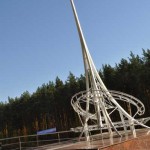
Europe-Asia Marker, Yekaterinburg, Russia
I love trains. A Trans-Siberian journey has been on my must-do list for three decades. My dream finally came true when I left London for Hong Kong upon completion of my assignment in London. As I only had 20 days and wished to visit as many places as possible, I gave up the idea of taking the classic 9289km-long Trans-Siberian railway from Moscow to Vladivostok. Instead I made my journey overland following the Moscow-Beijing line and then tried the newly completed high-speed Wuhan-Guangzhou line. Ieft my office in London after work at 6:15 pm on Monday, September 13 to start my 12000km journey and visited ten cities en route. I finally reached home at 5:15 pm on Sunday, October 3.
The Journey
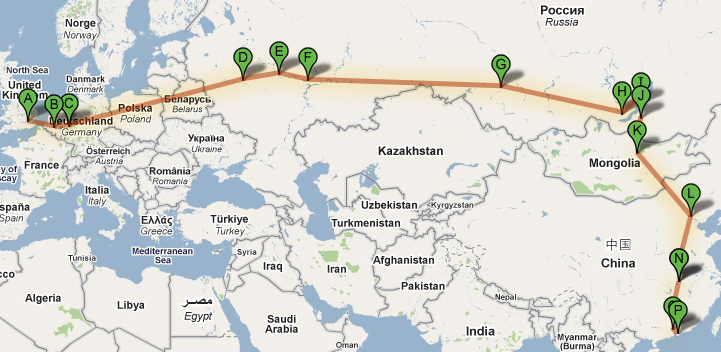
Route map : London to Guangzhou by train; Guangzhou to Hong Kong by bus
From
|
To
|
Distance(km)/Travel Time (hrs) |
London (13/9 at 1934hr)
|
Brussels
|
372 / 1:58 |
| Brussels* (14/9 at 1628hr) |
Cologne
|
180# / 1:47 |
| Cologne* (15/9 at 0230hr) |
Moscow
|
2000# / 34:00 |
Moscow (16/9 at 1645hr)
|
Nizhni Novgorod |
442 / 4:40 |
| Nizhni Novgorod* (17/9 at 2115hr) |
Kazan |
328#/ 9:14 |
Kazan* (18/9 at 1945hr)
|
Yekaterinburg |
1130# / 16:00 |
| Yekaterinburg* (20/9 at 2123hr) |
Novosibirsk |
1519 / 19:52 |
| Novosibirsk* (22/9 at 1822hr) |
Irkutsk |
1643 / 30:38 |
| Irkutsk* (26/9 at 2100hr) |
Ulan Ude |
457 / 10:10 |
| Ulan Ude* (28/9 at 0655hr) |
Ulan Bator |
662 / 24:25 |
| Ulan Bator* (30/9 at 0715hr) |
Beijing |
1561 / 30:50 |
| Beijing* (2/10 at 2100hr) |
Wuchang |
1225 / 10:00 |
Wuhan (3/10 at 0900hr)
|
Guangzhou
|
922 / 3:15 |
| Guangzhou (3/10 at 1400hr)(bus) |
Hong Kong (1715hr) |
200 / 3:15 |
Note:
i. London to Guangzhou by train and Guangzhou to Hong Kong by bus
ii. Departure date and time(local) are indicated in bracket
iii. * = cities visited en route
iv. # = estimated distance
Day 1 (September 13, Monday) – Farewell, London, UK
I cleared my desk, left my office at 6:15pm with a sense of accomplishment and excitement and arrived at St Pancreas railway station at 6:45pm. Eurostar is fast and comfortable and I stayed with a colleague in Brussels and had a wonderful sleep.
Day 2 – Brussels, Belgium – Cologne, Germany (GMT+1): A memory lane
I had my first posting in Brussels in 1987 and it’s nice to see my former secretary, Anita and colleagues to say good-bye. I like mussels and had a huge bowl of mussels for lunch!
 |
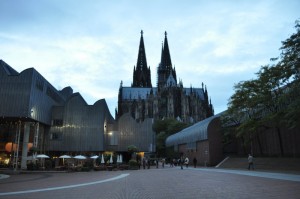 Cologne Cathedral and Music Hall |
|
|
My first visit to Cologne was in 1980. I had a three-hour tour of the city while waiting for my train. I find Cologne taking on a smart modern look with interesting urban architecture and river-side development.I revisited the Cologne Cathedral (a World Heritage Site), saw an interesting photo exhibition of aerial views of many famous heritage sites by the German Aerospace Centre and strolled along the river.
The train to Moscow which was scheduled for 10:28pm was late. I waited more than three hours on the platform and the train did not leave till 2:30am. It was most frustrating and tiring.
Day 3 -4 – Train to Moscow, Russia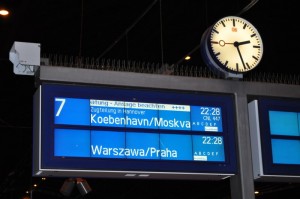
I spent 34 hours in the train and had a most eventful ride. First, the train was late by four hours.
Second, I could not get into my assigned carriage 183 till 6:30am. At the Cologne Station, the Polish train attendant who spoke no English simply told me to go to Carriage 181 which would terminate at Poland without explanation. I subsequently found out that more carriages would be added at the Hannover Station including Carriage 183.
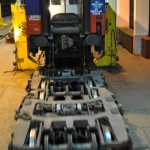
Bogies-changing
Third, I was almost left behind in the shed where the train changed its bogie at the Poland-Belarus border around 6pm. Trains run on a wider gauge in Belarus, Mongolia and Russia and have to change from the standard gauge to the 1.5-m wide one at the border. The train went into an enormous shed and I watched the fascinating and elaborate process from the train for over half an hour.When the train stopped with the door wide open, I descended to the platform to take a few photos. The train suddenly closed its doors and moved on leaving me behind! I yelled for help and a workman shouted to someone on the train which stopped just in time to let me on. But I got a nasty look from the train attendants when I walked back to Carriage 183.
Day 4 – Moscow – Nizhni Novgorod (GMT+3): A frightful beginning
I arrived in Moscow at midday and waited for a few hours for another train to Nizhni Novgorod. I arrived at the hotel with areservation around 9pm. The manager however refused to allow me to stay pointing out that I did not have a proper visitor card. She said my transit visa for Belarus expired on September 16 and I did not have a visa for Russia. I explained to no avail that as a Hong Kong Special Administration Region passport holder, I could visit Russia visa free for 14 days.
Around midnight, I was put on a taxi heading to a nearby guesthouse suggested by the hotel which is located in a typical soviet block building with iron-barred windows! I could not sleep worrying that I might encounter similar problems for the rest of my journey and I feared I might be burnt to death in case of fire!
Day 5 – Nizhni Novgorod
Nizhni Novgorod, founded in 1221 at the junction of the Oka and Volga Rivers, was once an important and prosperous trading centre. It has an impressive krelim built in the 16th century with 12 red towers.
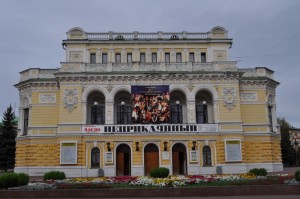 |
 |
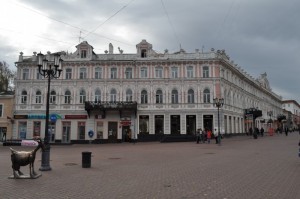 Building on Bolshaya Pokrovskaya |
I also visited two art museums and the Gorky Literary Museum (a famous novelist and playwright born in the city in 1868). Bolshaya Pokrovskaya, the main street leading to the krelim is lined with fine buildings including some striking art nouveau buildings. The Central Bank is a fine example. Nab Verkhne-Volzhskaya is also lined with grand mansions overlooking the Volga River. The Ostrog where prisoners exiled to Siberia were kept overnight on their forced march to the east, was on my list but I had no time to make a visit.
The city seems to be undergoing a face-lifting process and some buildings have been renovated. It is not an exciting place but still worth visiting.I took an overnight train to Kazan and shared a 4-bedded compartment with three men (a Japanese studying journalism at the Kazan State University, his Peruvian friend and a Russian). The young Janpanese is lively, speaking both Russian and English.
Day 6 – Kazan (GMT+3): A beautiful city
Kazan, one of Russia’s oldest Tatar cities dating back to 1005, is the capital of the Tatarstan Republic. The star attraction is the krelim which is a World Heritage Site. I spent hours exploring the enormous kremlin including the Kul Sharif Mosque, the Annunciation Cathedral designed by the same architect responsible for St Basil’s Cathedral at the Red Square, the State Art Museum with many paintings from the Kazan school of painting. I also visited the St Paul and St Peter Cathedral, the University of Kazan where Lenin had studied but was expelled for his revolutionary activities.
I was impressed by the elegant and impressive buildings along the tree-lined Kremlyovskaya ul. There are many nice restaurants and cafes and I spent a couple of hours eating and drinking coffee in order to use my iPad. I bought some fruits at the central market and instant cup noodles for my overnight train ride.I shared a compartment with a nice Russian couple and a train attendant, Olga. Though they did not speak English, we managed to communicate using sign language. I also took some of their bread, cheese and dried meat.Day 7 & 8 – Yekaterinburg (GMT+5) : A nice surprise
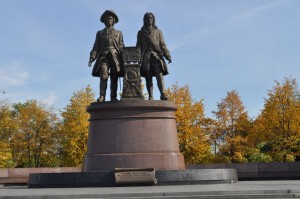
Yekaterinburg (population: 1.3 million) founded by Tatishchev and De Gennin, began in 1723 at the plotinka (little dam) area. It’s now Russia’s fourth largest city and an important mining, industrial, cultural and transportation centre. The city is also educationally rich with some 50 technical schools and 15 higher education institutions. It is a pleasant and vibrant city with a lot of young people/students and a nice mix of old and new buildings. Public transportation is cheap and efficient.
Yekaterinburg has played a significant role in shaping Russian history. After the revolution in 1917, Nicholas II, his wife and five children spent their last days in Yekaterinburg. The Church of Blood is built on the site where the Romanov family was murdered by the Bolshevik troops on 16 July 1918.Yekaterinburg came to the world attention again in May 1960 when an American U2 pilot was shot down (i.e. the famous U2 Affair). The first President of the Russian Federation, Boris Yeltsin was the first secretary of the Communist Party of the Soviet Union of the Committee of Sverdlovsk Oblast which administrative centre is Yekaterinburg from 1976 to 1985.
Yekaterinburg is bordering both Europe and Asia. I took an excursion to visit the Europe/Asia marker which is not impressive nor creative. The autumn colours were gorgeous. I however find a memorial nearby built in honour of 1,000 bodies found in a mass grave in the forest, remarkable and worth visiting. These men/women were killed during the Stalin era from 1930s to 1940s. My stay in Yekaterinburg has helped me understand Russia’s history in the last century.
I went to Ganina Yama, 16 km northeast of Yekaterinburg where the bodies of the Royal family were discarded. In their honour, the Orthodox Church has built the exquisite Monastery of the Holy Martyrs. Seven churches built in wood with different designs now commemorate the burial of the Romanov family. The site has become a pilgrimage site. Furthermore, the late Tsar and his family were canonized in August 2000.
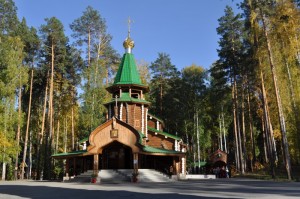 Monastery of the Holy Martyrs |
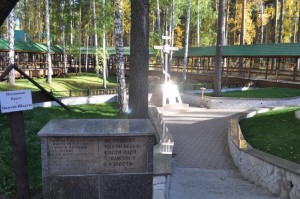 Ganian Yama |
I had a relaxing and wonderful time without encountering problems at the hotel. The receptionist did ask about my visitor card three times but finally accepted my explanations. I had a nice room with a comfortable bed and had a good sleep for the first time since leaving Brussels on September 14!
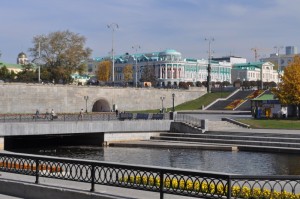 Plotinka (little dam) area |
 |
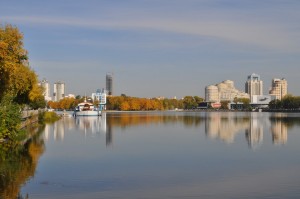 City pond |
While we have ‘One Country, Two Systems’ in Hong Kong, I discovered Russia has ‘One Country, Two Time Systems’. Russia is a vast country with nine time zones but all trains are running on Moscow time. I did not realise this till I arrived at the Yekaterinburg station and was told that I was two hours early for my train to Novosibirsk! I met a nice couple, Natashya and Ignor (who is a pilot) who brought cheese, bread, fruit with them and invited me to have supper with them.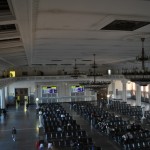
Novosibirsk, founded in 1893 on the banks of the Ob, is Russia’s third largest city (pop : 1.5 million) and the gateway to Siberia. It boosts the largest railway station along the Trans-Siberian Railway, an enormous opera and ballet theatre at Pl Lenina which has a huge statue of a wind-blown Lenin.
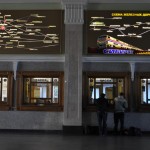
Huge ticketing hall
I find the city a typical product of the soviet era without charm. Nonetheless, two discoveries made my stay less boring. I met a friendly and beautiful young hotel receptionist who helped me find a room at the railway station’s ‘rest room’ (a simple guesthouse located above the station. The place us clean and convenient. I also discovered the paintings of N.K. Roerich in the Novosibirsk Art Museum. His Himalayas series were very impressive and inspiring and prompted my interest to visit the Altai mountains located at the border of Mongolia, Russia and China.
Day 11 – Train to Irkutsk
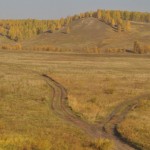
Golden Siberia
For the first time, the landscape is less monotonous with rolling hills. The scenery was more picturesque with trees in all shades of golden green colours, wheat fields and patches of dark brown/black soil. I felt hungry after finishing off my two cups of instant noodles and went to the restaurant car for a steak. The attendant took my order but the steak never arrived! Instead, Oleg kindly treated me with a piece of his caviar sandwich.
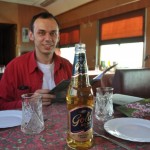
Oleg in a restaurant car
During the 30-hour long journey, I met three Russian passengers in my compartment. Alex, a professor of physics, has been teaching in Tokyo, Japan and Hebei, China. He is adamant with some of the changes which have resulted in a widening gap between the rich and poor and eroded the traditional values. He is also critical of the education reforms. Alex and the other Russian passenger got off at Krasnoyarsk and Oleg, a young battery salesman from St Petersburg, took up one of the empty beds. He was on his way to Irkutsk to give a presentation to his customers.
Day 12-14 -Irkutsk and Olkhon Island (GMT+8): Highlight of my trip
Irkutsk is a ‘must’ stop on the Trans – Siberian route and the star attraction is Lake Baikal, a World Heritage Site for its natural beauty and unique ecosystem. The Lake is the world’s largest fresh water as well as the deepest lake (1637m) holding over 20% of fresh water on earth. There are many things to do including a visit to Listvyanka, an attractive village of wooden houses beside the Lake and Bolshie Koty, a ride on the 95-km long Circumbaikal Railway, and a side trip to the Olkhon Island, the largest island (70km long and 15 km at its widest point) on the Lake.
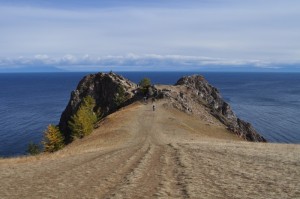
Cape Khoboy, Olkhon Island
I decided to make a side trip to the Olkhon Island as I was anxious to go beyond the railway line and see the countryside. The journey took about six hours. The minibus first drove north for 250 km along the Primorsky Mountains on Baikal’s western shore to the Island ferry pier. The crossing only took about ten minutes followed by another 30-minute drive to Khuzir, the largest settlement on the Island. The route is very scenic with rolling hills, forests, farms and open fields with many wooden houses. Instead of staying at a guesthouse, I chose home-stay so that I can have a glimpse of the normal life on the island. I shared a room with Danielle, a retired French lady and met six other backpackers including Louis and Laura from Austria, Hilda and Eirik from Norway and a couple from Poland.
Danielle and I joined a full-day tour on September 13. We stopped to take a look at a gulag (which stands for the vast bureaucracy of resettlement programs, labour colonies, concentration camps and special psychiatric hospitals), a couple of lookout points and the ‘Three Brother’ rocks located on the western shore of the island, Khoboy (a stunning 200-m high clifftop) at the far northern tip of the island and a beautiful green valley on our way back to Khuzir.
 Autumn colours |
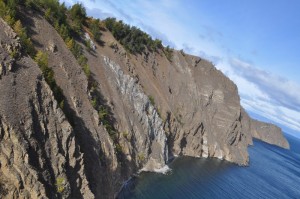 Steep and spectacular cliffs |
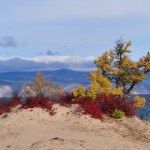 Sand dunes |
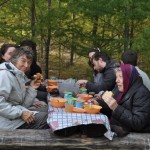 |
After spending two lovely days on the island, I had to leave for Irkutsk, which is known as ‘Paris of Siberia’. I spent a leisure afternoon exploring the city on foot visiting the Church of the Elevation of the Cross, the Regional Museum, the Art Museum, the Cathedral of the Epiphany, the Znamensky Monastery with turquoise domes and the Central Market.
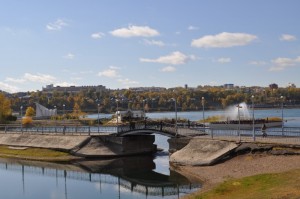 I also strolled along the Angara River and took a look at the Trans-Siberian Builders’ Monument. It is worth remembering that this immense project was given the thumb-up by Tsar Alexander III in 1886 followed by a decree in 1891 and the whole line to Vladivostok was completed in 1916. Standing in front of the Monument reminds me of the ambitions of the Tsar government to consolidate its power in the east since the 19th century and its determination to overcome the challenges posed by engineering, supply and labour. Over 1000 million rubbles were spent in constructing the line and many workers had lost their lives. Not much has changed since its opening ( including its speed, standards and service) : one still takes seven days to cover the entire journey.
I also strolled along the Angara River and took a look at the Trans-Siberian Builders’ Monument. It is worth remembering that this immense project was given the thumb-up by Tsar Alexander III in 1886 followed by a decree in 1891 and the whole line to Vladivostok was completed in 1916. Standing in front of the Monument reminds me of the ambitions of the Tsar government to consolidate its power in the east since the 19th century and its determination to overcome the challenges posed by engineering, supply and labour. Over 1000 million rubbles were spent in constructing the line and many workers had lost their lives. Not much has changed since its opening ( including its speed, standards and service) : one still takes seven days to cover the entire journey.
I took an overnight train to Ulan Ude which turned out to be a nightmare. As I did not know the train timetable is based on Moscow time, I brought a ticket departing around midnight which actually means early morning local time. As I had not travelled in a third class carriage before, I decided to try once. It is the biggest mistake I have made.
First class and second class have closed compartments with two or four berths respectively. A second class carriage with 8 closed compartments takes 32 passengers maximum. But a third class open carriage packs in some 100 berths. The carriage was crowded, noisy and hot and I could not open the windows. Though I am not overweight, I had difficulties in gettting into the middle berth allocated to me. I could hardly breathe and thought I might have a heart attack. I had a sleepless and restless night and was relieved when the train reached Ulan-Ude. I vow I will not travel in a third class carriage (unless there is no alternative). I am too old to stand the heat and noise and prefer some comfort and privacy!
Day 15 – Ulan Ude (GMT+8)
As soon as I arrived at the Ulan Ude station, I took a room at the railway station’s rest room and had a hot shower. I had two hours’ sleep before sight-seeing.
Ulan Ude, the capital of the Buryar Republic, has a different atmosphere. I took a taxi to Ivolgindk Datsan, a monastery complex built in the mid-19th century and located some 40 km outside the city. It is now the centre of Buddhism in Russia. I returned to the city and visited the Virgin Hodegetria Cathedral built in the 18th century. At the heart of the city is the main square (Ploshchad Sovetov), which is dominated by a head of Lenin (the largest in the world). I was unable to visit the History Museum and the Geological Museum as both were closed.
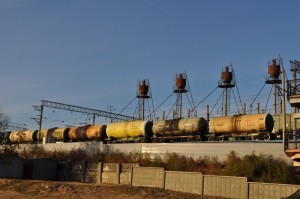 Ulan Ude station |
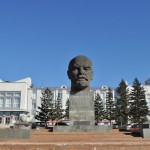 Lenin Head, pl Sovetov |
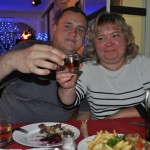 Denis & Lorna |
The city is not economically developed and has a fairly relaxed atmosphere.I had dinner on my own in a restaurant near the railway station and met Denis and Lorna. They looked at my fish with dismay and told me in broken English that I should eat meat and drink Vodka. They invited me to try their grilled meat and gave me two small glasses of Vodka – the first Vodka I had on this journey. Denis is a typical Russian who drinks as many as three bottles of Vodka a night! Drinking is indeed a problem and both Denis and Lorna are obese as a result of over-eating and drinking.
Day 16 – Train to Ulan Bator, Mongolia
I was very moved to find Denis at 6am at the train station. He made sure that I got on the train!
The train to Ulan Bator was very slow taking almost a whole day to cover less than 700km. It would be faster and cheaper to travel by coach. The scenery was more picturesque with blue sky, white clouds, vast steppes, mountains, valleys and flowing rivers and horses and cows grazing in a distance.
 Mrs Simpson (R) |
|
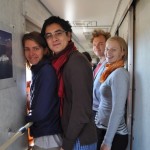 |
I shared the compartment with an 82-year old Canadian, Mrs. Simpson and a Mongolian lady. Mrs. Simpson was travelling alone from Canada to Moscow to board the Trans-Siberian train with four suitcases and two walking sticks. She cannot walk without support. We all tried to help her. I admire her courage and determination but do not think I wish to travel on my own if I cannot not walk or take care of myself properly. In the corridor, I saw Louis, Laura, Hilda and Erik whom I met at the home stay on the Olkhon Island and many international travellers.
Day 17 – Ulan Bator (GMT+8)I arrived in Ulan Bator fairly early and went with other travellers to a local hostel which is well-run and clean. I took a one-day private tour. Jag, a young Swedish student on a six-month trip in China who stayed in the same hostel, joined me and we shared the cost. We visited the Ganda Monastery, the Zaisan Memorial for a panoramic view of the city before heading to the Terelj National Park. We had lunch in a nomad family’s ger and the food was simple but delicious. In the afternoon, we had two hours’ horseriding and visited a Tibetan temple. I find the gorgeous scenery with blue sky, beautiful mountains and valleys, yellow and golden fir trees spoilt by litter and some ugly gers built for tourists. On the way back, we stopped at a newly completed monument with a 40-metre high statute of Genghis Khan on horseback. I had a most enjoyable day.
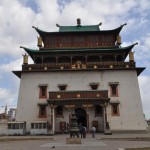 Gandan Khiid |
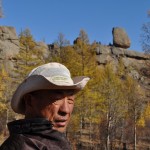 |
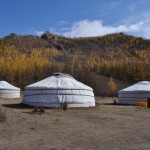 |
 Genghis Khan monument |
Day 18 – Train to Beijing, China
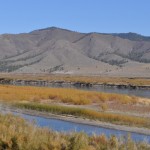
I spent another day on the train sharing the compartment with two Norwegian young students on a China/Asia trip. The scenery of the steppe though pretty no longer arouses excitement. When we arrived at the Mongolia-China border, we had to remain in the compartment and were cleared first by the Mongolian officials followed by the Chinese. The Chinese officers inspected and took our travel documents to the main building for processing. As a Hong Kong Chinese, I use my home-visit permit card (which size is similar to a credit card) for travel in China. The officer took my card but forgot to bring it back together with other passports. As I result, I had to go with her to the immigration building to collect my card and raced back to the train. The train waited patiently and pulled out of the station once I was on board!
The train entered a huge shed and repeated the same elaborate bogie-changing process again. But this time, the train was divided up into two halves (as it was much longer with more compartments) and the bogies seemed to be changed at a faster pace. I was so tired that I felt asleep before the whole process was completed.
Day 19-20 – Beijing (GMT+8 )
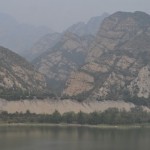 I got up early and spent the morning in the corridor watching the scenery or in the restaurant car which is comfortable with nicer food. The train passed through a mountaineous region with deep gorges and pine trees and the scenery is becoming more ‘Chinese’ similar to those in traditional Chinese paintings. The railway tracks on the Chinese territory are tidier and the surrounding areas much cleaner. Land is also under more intensive cultivation. Bigger and more prosperous towns appear. I could hardly recognise Datong which I visited in 1990s. It is over 380km from Beijing with a population of 3 million. With rapid economic development as Shanxi province’s industrial centre, its town centre is now filled with new high-rise buildings.
I got up early and spent the morning in the corridor watching the scenery or in the restaurant car which is comfortable with nicer food. The train passed through a mountaineous region with deep gorges and pine trees and the scenery is becoming more ‘Chinese’ similar to those in traditional Chinese paintings. The railway tracks on the Chinese territory are tidier and the surrounding areas much cleaner. Land is also under more intensive cultivation. Bigger and more prosperous towns appear. I could hardly recognise Datong which I visited in 1990s. It is over 380km from Beijing with a population of 3 million. With rapid economic development as Shanxi province’s industrial centre, its town centre is now filled with new high-rise buildings.
Finally, I arrived in Beijing in the afternoon on October 1, which is the National Day of the People’s Republic of China. It’s the first time I was in the capital on such a special occasion. I had dinner with my colleague, Thomas and met up with CT, a friend from London who was in Beijing to attend the National Day celebrations. I was lucky to meet a friend of CT who is a tea connoisseur. He brewed tea leaves which cost some RMB 20,000 a catty. It is the most expensive cup of tea I have ever had in my life!
I spent my last night on the train to Wuchang where I need to take a taxi to the new high-speed train station at Wuhan. My bed in a 4-berth compartment was clean and comfortable. Each berth is provided with its own TV screen and passengers can watch the movie channels free of charge. Trains in China are modern and better value-for-money than those in Russia and Mongolia.
Day 21 – Wuchang – Wuhan – Guangzhou – Hong Kong
The high-speed train from Wuhan to Guangzhou covering some 1000km in three hours, has commenced operation since 26 December 2009. The efforts China has devoted to infrastructural developments, the high-speed trains in particular, are remarkable. Travelling in China by rail now is efficient and comfortable. I brought a first class ticket. Though the seat is comfortable and spaceous, there is hardly room for my luggage. The train attendants stopped me from taking pictures of the bar/restaurant areas. Some passengers in the first class compartment made a lot of noises and four passengers even set up a table to play cards. Hence, while the hardware such as station and track developments are catching up fast, the software requires further improvement.
I originally intended to travel all the way to Hong Kong by train. But when I discovered that a direct bus from Guangzhou South Terminal would be leaving in less than two hours’ time, I decided to take the bus instead. I had a pleasant ride and Wai Leuk, my nephew opened the door and welcomed me home. I was finally home after living abroad since June 2001.
Remarks
This 21-day journey covering some 12,000km is the longest overland journey I have ever made. The scenery is not scenic all the way and nothing extraordinary has happened. But I am glad to make an overland journey and have done half of the Trans-Siberian line. I have spent altogether 11 nights on the train with ten stopovers.
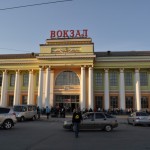 Yekaterinburg station |
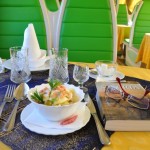 Breakfast, restaurant car |
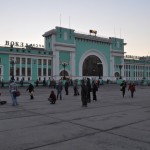 Novosibirsk station |
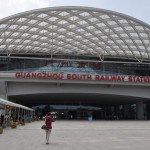 Guangzhou station |
This train journey though no longer a novelty, is still a once-in-a- life-time journey. There are many cities along the route worth visiting. I wish I had more time (as many as two to three months) for this epic overland journey. There are several aspects of the journey I treasure most.
First, I had been on business trips to Moscow, St Petersburg and Vladivostok many times meeting officials, businessmen, journalists etc. But it’s the first time I met men in the street. They are honest, funny and sociable (many are obese as well!). The two young receptionists I met in Yekaterinburg and Novosibirsk are lovely and most helpful. Denis offered me my first glass of Vodka. I fully appreciate the generosity of my Russian friends who shared their food and drink with me.
Second, this is an eye-opening journey for me. Though the scenery along the route on the Russian soil is not too impressive and the facilities on the Russian trains are basic, the journey enables me to have a better feel about Russia. I have learnt more about its history and people. I am amazed by the way the late Tsar and his family has attained sainthood and how the Church of Blood and Ganina Yama have become pilgrim sites. The psyche, religions and culture of Russia are fascinating.
Third, Russia occupies a huge land mass with nine time zones. The total length of the classic Trans-Siberian Railway which foundation stone was laid on 31 May 1891 at the Vladivostok Station, is 9,289km. I have only done 5,642 km from Moscow to Ulan Ude. I hope to visit Kamchatka and then travel by train from Far East Russia to Lake Baikal or Krasnoyarsk and the Altai Mountain region as Part II of my Russian journey.
Fourth, the journey through Russia, Mongolia and China in one-go is fascinating. The three countries have undergone changes at different pace. Development in China in the past 20 years has been extraordinary. As a Chinese, I am proud to see it entering a high-speed rail era. While a 1000km-journey in Russia and Mongolia roughly has taken me some 20 to 30 hours, it only takes three hours in China. If Russia and Mongolia would adopt the world gauge standard and have a more efficient system, I suppose the travelling time in these two countries might be considerably reduced and Asia and Europe could be physically taken as one continent!
Mongolia and the Olkhon Island have exceptional natural beauty. I am concerned about development and environment protection of these pristine regions.
The Olkhon Island has obviously benefitted from tourism. I was told that during the peak season in July-August, it receives some 1,000 visitors a day. It is not surprising to find many resorts under-construction. But the ecosystem is fragile and I am concerned about the adverse impacts of excessive development on the island.
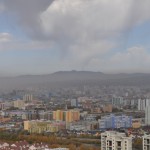
Ulan Bator in smog
The landscape of Mongolia is spectacular but pollution is a serious problem in Ulan Bator. 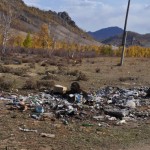 The magnificent scenery in the Terelj National Park is also marred by litter and ugly hotel developments providing gers for tourists. The negative impacts of economic and tourism developments should be minimized by proactive policy and planning. The relevant authorities must ensure development in a sustainable manner.
The magnificent scenery in the Terelj National Park is also marred by litter and ugly hotel developments providing gers for tourists. The negative impacts of economic and tourism developments should be minimized by proactive policy and planning. The relevant authorities must ensure development in a sustainable manner.



























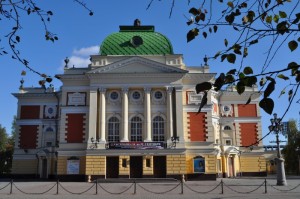
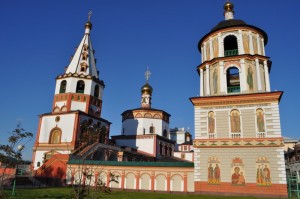



















Hey Sarah
A trans-Siberian journey by train is my dream too:) Although I don’t know when it will come true… I cannot stop reading your travel blog!
Anli
At last I locate you. What a great traveler you are! I treasure the exciting times when we were exploring the Russian market for HK.